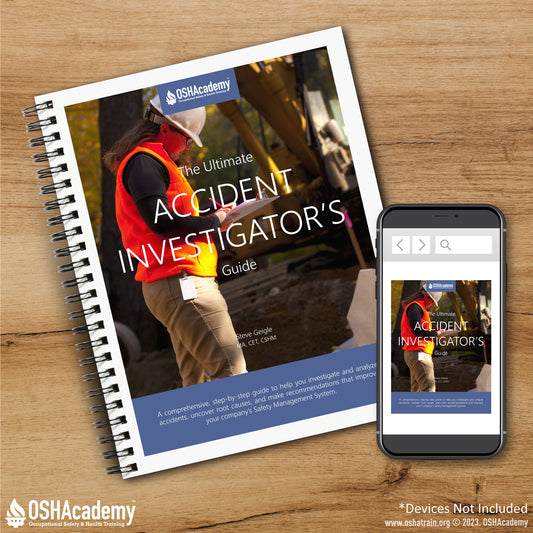
HIPAA Compliance & Infection Prevention Tips
Share
By Jennifer Thompson
OSHAcademy Business Development & Relations Manager
Ensuring safety within the healthcare settings is crucial, both for the health of patients and for safeguarding healthcare workers. By focusing on key safety issues and potential risks, healthcare professionals can create a more secure environment for all involved. Below are some important topics that every healthcare facility must address.
HIPAA Privacy Training
HIPAA (Health Insurance Portability and Accountability Act) Privacy Training is essential for protecting patient information. This training ensures all healthcare workers understand the importance of confidentiality and are aware of the procedures to protect patient data. Regular training sessions can help prevent unauthorized access to personal health information, thereby maintaining trust and compliance with federal regulations.
Since the compliance date of the HIPAA Privacy Rule in April 2003, the Office of Civil Rights (OCR) has received more than 351,372 HIPAA complaints and has initiated more than 1,183 compliance reviews. To date, OCR has settled or imposed civil money penalties in 142 cases, resulting in a total dollar amount of $142,448,772.00. The investigated complaints were made against many different types of entities including, hospitals, physician offices, pharmacies, outpatient facilities, community health centers, and health plans.
It's crucial for your team to understand parts of the HIPAA law, like privacy and security rules, and how to keep patients' information safe. OSHAcademy course 625 HIPAA Privacy Training provides more information on these important compliance requirements.
Bloodborne Pathogens
According to the National Institutes of Health, it is estimated that approximately three million exposures to bloodborne pathogens occur annually. Most often this is due to accidental punctures. Bloodborne pathogens training is crucial for anyone who might come into contact with blood or other potentially infectious materials. OSHAcademy course 656 Bloodborne Pathogens Training in the Healthcare Setting educates healthcare workers on the risks associated with bloodborne pathogens such as HIV, hepatitis B, and hepatitis C, and provides guidance on the proper procedures for handling and disposing of sharps and other contaminated materials. The goal is to minimize exposure and prevent transmission of diseases.
Infection Prevention
According to the Centers for Disease Control and Prevention (CDC), about one in 31 patients in U.S. hospitals and one in 43 residents in nursing homes acquire at least one Hospital Acquired Infection (HAI) each day. A significant number of these infections are due to bacteria such as C. diff and methicillin-resistant Staphylococcus aureus (MRSA), which can transmit to individuals through surfaces in healthcare facilities.
“Bacteria multiplies very rapidly and can live on surfaces indefinitely”, says Benjamin Galvan, director of infection prevention at Florida South Tampa Hospital. He continues by saying, “If we are not cleaning or disinfecting properly, then we are increasing the possibility of spreading pathogens to our patients through contaminated hands and surfaces.” Healthcare facilities should have clear protocols for infection control and provide ongoing training to staff to ensure these practices are followed consistently.
OSHAcademy course 138 Workplace Hygiene and Illness Prevention explains how to prevent the spread of infectious diseases. It includes the following topics:
- proper hand hygiene
- cleaning & disinfecting
- the use of hand sanitizer
- indirect transmission
- and much more
Personal Protective Equipment (PPE)
Another infection prevention tool is to correctly utilize Personal Protective Equipment (PPE) while attending to patients. PPE serves as a shield for healthcare professionals against harmful pathogens by blocking contact with bodily fluids and respiratory droplets. Using PPE properly is one of the top methods for safeguarding both patients and healthcare workers against infectious agents. Additionally, careful application (donning) and removal (doffing) of PPE are essential actions to minimize the risk of contamination.
Emphasizing the importance of PPE and ensuring that it is readily available and used correctly can be a vital tool for protecting healthcare workers from exposure to infectious agents and hazardous materials in the healthcare setting.
Lack of proper training and education can adversely affect adherence to PPE protocols. OSHAcademy offers a great course, 178 Healthcare: Personal Protective Equipment, to help your team understand the importance of PPE. This training covers the proper selection, use, and disposal of PPE, including gloves, masks, gowns, and eye protection.
In conclusion, by focusing on these key areas, healthcare facilities can create a safer environment for patients and healthcare workers alike. It requires a commitment to regular training, adherence to established protocols, and a culture of safety that prioritizes the well-being of everyone involved. Through diligent efforts in these areas, healthcare facilities can significantly reduce the risk of privacy breaches, infections, and other safety concerns.
Works Cited
Office for Civil Rights (OCR). “Enforcement Highlights - Current.” HHS.gov, 20 Nov. 2015, www.hhs.gov/hipaa/for-professionals/compliance-enforcement/data/enforcement-highlights/index.html.
FMLink. “Examining the State of Infection Prevention in 2023.” FMLink, 12 July 2023, www.fmlink.com/articles/examining-state-infection-prevention-2023/. Accessed 20 Feb. 2024.




1 comment
Good read!!